| ■ J-PARC News - February 2017 (Issue #142) |
| ● 4th Accelerator Facility Safety Symposium (January 26-27, Ibaraki Quantum Beam Research Center (IQBRC)) |
|---|
| Since the radioactive material leak incident at the Hadron Experimental Facility in 2013, the J-PARC Center has held safety symposiums every year for information-sharing and discussions to improve safety with persons involved with accelerators both inside and outside Japan. The featured topics this time were emergency response and electrical safety in accelerator facilities, and the event was held with the participation of 131 attendees, including 47 from outside organizations such as Japanese accelerator facilities, universities, and companies. The content of the 12 talks by the various organizations was thought-provoking, touching on stories of failures, other experiences, ingenious efforts at various facilities, and related topics. Facility profiles and other information were also shared at the poster corner, and mutual understanding and collaboration were deepened with regard to safety at accelerator facilities. |
 
 * Click here to enlarge. * Click here to enlarge. |
| |
| ▲to Page Top |
| |
|
| ● Study Meeting on Diagnosis Systems for Trouble and Presage (January 25, J-PARC) |
|---|
| At J-PARC, close to 10 years have passed since the start of operation in 2008, and facilities are being sensibly operated with proper maintenance. However, as an experimental facility used by many users from both inside and outside Japan, it is essential to operate stably with a high availability factor, and thus there is need to introduce diagnosis of equipment troubles and the presages as part of operation work, and strive for management with a higher degree of reliability. At this study meeting held recently, involved persons from corporations and universities were invited, and they gave an overview of predictive diagnosis systems used for trouble diagnosis of rotating systems in air-conditioning equipment. Also, from the J-PARC Center, Dr. Takashi Naoe from the Neutron Source Section and Dr. Wan Tao from the Target Technology Development Section reported on the development situation for a trouble diagnosis system for high-intensity neutron sources, and discussed approaches for safe operation of facilities. |
| |
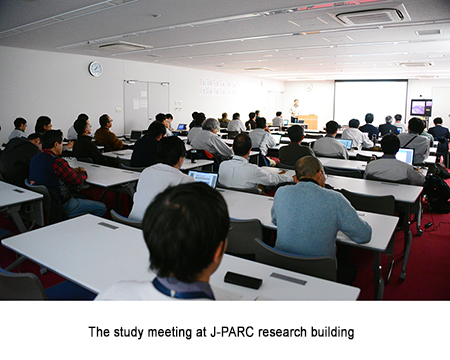
 * Click here to enlarge. * Click here to enlarge. |
| |
| ▲to Page Top |
| |
|
| ● The 19th CROSSroads Workshop Series - Neutrons and Muons for Interface Investigation- (February 13, IQBRC) |
|---|
| The Neutron Science and Technology Center of the Comprehensive Research Organization for Science and Society (CROSS) is in charge of promoting the use of seven shared beamlines installed at the Materials and Life Science Experimental Facility (MLF), and in 2011 the center began a series of workshops called "CROSSroads of Users and J-PARC." At the MLF, research is being conducted on materials and life science by using the world's highest intensity neutron and muon beams, produced by a pulsed proton beam from an accelerator. |
| At this 19th research meeting, there were explanations of the latest technologies for measurement of muons and neutron reflectivity, and presentations were given on various studies using these techniques, based on the keyword "boundary surfaces" and relating to batteries, polymers, magnetic functional materials, and so forth. There were 52 registered participants in the meeting, and at all eight talks there were lively question-and-answer sessions. In the concluding session, participants discussed new possibilities using research complementary with neutron reflectivity measurement accompanying the realization of ultra slow muons. For the research meeting program and other details, please see the CROSS Tokai home page. |
| |
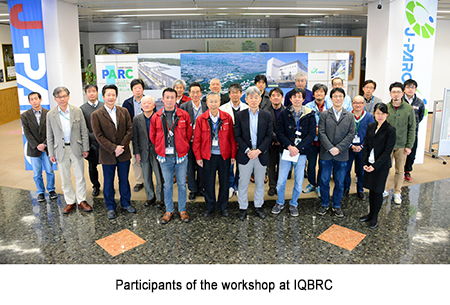
 * Click here to enlarge. * Click here to enlarge. |
| |
| ▲to Page Top |
| |
|
| ● Held 23rd J-PARC PAC (January 11-13, J-PARC) |
|---|
| From January 11 to 13, the J-PARC Program Advisory Committee for the Nuclear and Particle Physics Experiments at the J-PARC Main Ring (J-PARC PAC) was held with 15 committee members, including eight from overseas. This committee reviews nuclear and particle physics experiments conducted primarily using J-PARC's 50 GeV Synchrotron (MR), and agenda items of this meeting included reports on the current status and future outlook for J-PARC facilities, confirmation of progress of experiments conducted at the Neutrino and Hadron Experimental Facilities, and review of whether to adopt new proposals. In an open session extending from the first to the second day, many facility staff and users packed the venue, and the committee listened to presentations including more than 20 experiment proposals. |
| |
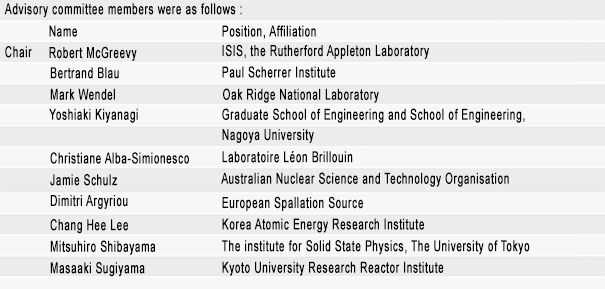
 * Click here to enlarge. * Click here to enlarge. |
| |
| ▲to Page Top |
| |
|
| ● Exhibited Booth at American Association for the Advancement of Science (AAAS) (February 16-20, Boston, Massachusetts, U.S.) |
|---|
| At the Annual Meeting of the American Association for the Advancement of Science (AAAS), held for four days from February 16, the J-PARC Center exhibited a booth jointly with the Japan Society for the Promotion of Science, Institute of Physical and Chemical Research (RIKEN), National Astronomical Observatory, Kyoto University, and others. The American Association for the Advancement of Science is an NPO created by scientists which cuts across various fields, and it publishes the scientific journal "Science." At the annual meeting held every year, a wide variety of people involved in scientific research gather not only from all over the U.S., but also from throughout the world. The participants include researchers, as well as high school students, university students, graduate students, journalists, and PR staff from research institutions. At this meeting, Dr. Takaaki Kajita, Director of the Institute for Cosmic Ray Research, University of Tokyo, participated as a speaker at a symposium on gravitational waves. A variety of visitors came to the J-PARC booth, and many were seen listening intently to the explanations of Saeko Okada, Leader of J-PARC's Public Relations Section. One researcher asked the question: "What is the best way to apply for a proposal?" Ms. Okada also spoke on reporting at a career workshop for researchers entitled "Understanding the Media: What Makes a Good Science Story?" and presented examples of reporting in Japan relating to the T2K (Tokai to Kamioka) experiment. |
| |
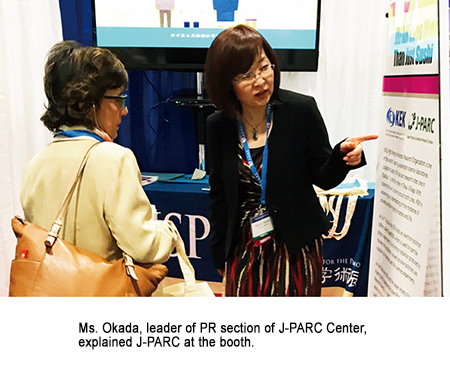
 * Click here to enlarge. * Click here to enlarge. |
| |
| ▲to Page Top |
| |
|
| ● Held Flower Arrangement Class (January 23, Advanced Science Research Center, Nuclear Science Research Institute) |
|---|
| On January 23, the International Affairs Department of the JAEA, the Tokai-mura International Association (TIA) and J-PARC Center held a flower arrangement class as part of the lead up to the fiscal 2016 JAEA Cultural Festival. There were 23 participants, including 11 foreign researchers working within the JAEA. The participants worked eagerly to produce arrangements based on guidance by the instructor from TIA, and among the participants who experienced the fun of flower arrangement, some were seen to produce two or three works. From the 24th to the 27th, their arrangements were used to decorate the first floor lobby of the Advanced Science Research Center of the Nuclear Science Research Institute, delighting the eyes of researchers visiting the center and lovers of flower arrangement. |
| |

 * Click here to enlarge. * Click here to enlarge. |
| |
| ▲to Page Top |
| |
|
| ● Workshop for Making Keychains with Chirimen Cloth (February 10, KEK Tokai Dormitory) |
|---|
| Collaboration meetings for the T2K experiment are held a few times every year in Tokai village, and each time close to 150 researchers visit from overseas. At every meeting, an event to provide new experiences is being held at J-PARC, as settings for mingling with overseas researchers and encountering traditional Japanese culture, and many researchers participate in the class. |
| To coincide with the collaboration meeting for the T2K experiment held from February 6, a workshop for making keychains with chirimen cloth was held by the J-PARC Center. Chirimen was provided as Japanese cloth, and about 40 participants including collaborators from overseas, worked for about an hour to make rooster/hen and owl shaped keychains while receiving instructions from staff on how to make each item. After finishing, the participants enjoyed the tone of the bell attached to the keychain, and the workmanship of a craft item with the warmth characteristic of Japanese cloth. |
| |

 * Click here to enlarge. * Click here to enlarge. |
| |
| ▲to Page Top |
| |
|
| ● J-PARC Visit by Minerva 21 (February 21) |
|---|
| On February 21, there was a visit by "Minerva 21," a network formed by interested mayors of municipalities who were born after the war in Ibaraki Prefecture. The group members are make up over 30 mayors of the 44 municipalities in the prefecture, and their aim is to strengthen collaboration by exchanging information, holding workshops, and otherwise working to develop their respective communities. Sixteen municipal mayors participated in this visit, and they deepened their understanding of J-PARC by touring the MLF, where research is conducted for industrial use, and inspecting equipment for the T2K experiment, a world-class experiment on elementary particles. |
| |
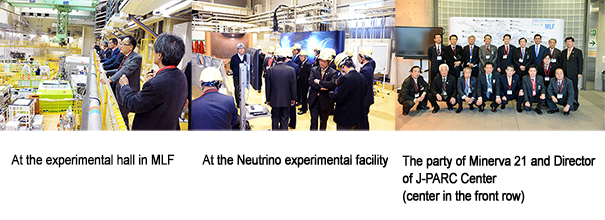
 * Click here to enlarge. * Click here to enlarge. |
| |
| ▲to Page Top |
| |
|
| ● Facility Situation |
|---|
| (1) At J-PARC, tests are being conducted to demonstrate laser charge conversion using a test stand installed in the klystron preparation room of the Linac Building, as a step toward future construction of a transmutation experimental facility. |
| (2) At the Hadron Experimental Facility, tasks underway include setup of an electromagnet in the High-p/COMET beamline on the south side of the hall. |
| (3) At the 50 GeV synchrotron (MR), operation is being conducted by raising the supply of the 30 GeV proton beam to the neutrino experimental facility from 460 kW to 470 kW on the 9th. |
| |

 * Click here to enlarge. * Click here to enlarge. |
| |
| ▲to Page Top |
| |
|
©2017 J-PARC Center. All rights reserved.
|
|